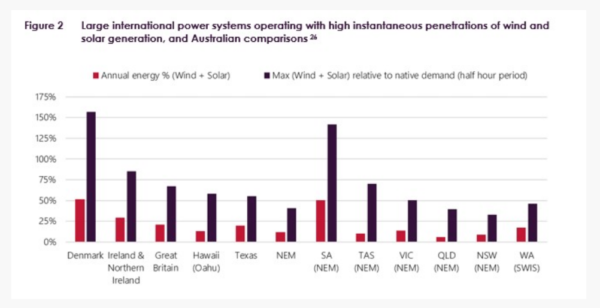In its latest paper, the Australian Energy Market Operator (AEMO) suggested that a staged approach to the energy transition may be necessary given the technical challenges associated with integrating variable inverter-based resources. It compared Australia with other international power systems and concluded lessons could be learned from other global leader operating with high instantaneous penetration of wind and solar generation.
In the report titled Maintaining system security with high penetrations of wind and solar generation, AEMO states that parts of Australia are already experiencing some of the highest levels of wind and solar generation in the world, including one of the highest levels of residential solar PV (graph below). “Australia is achieving these very high levels while at the forefront of connecting wind and solar generation in areas with low system strength,” AEMO said.

Looking at the electricity markets abroad, AEMO finds that international power system operators have taken a staged approach to operating power systems with progressively less synchronous generation online, noting that a similar approach could be considered in Australia.
“This could include taking a precautionary approach (such as mitigating risks and holding extra reserve) for a period (for example, one year) while the system is operated closer to its limits (for example, with fewer synchronous generators online) to build experience and confidence, before accepting those conditions as a new norm,” the report states.
DER integration
In terms of successful integration of high levels of distributed energy resources like rooftop solar, AEMO highlights the importance of an increasing level of visibility, predictability, and controllability of these small distributed devices.
With around 1 GW of small-scale solar PV on the grid at the end of June, South Australia is a living lab for the country’s energy transition. Last Sunday, the state set a new record for minimum operational demand at 475 MW, as rooftop solar led the way covering 64% of the total demand.
In the new report, AEMO suggests its needs to learn more about control over rooftop PV, noting that currently there is limited to no real-time visibility of PV systems under 5 MW. It points out that 70% of small-scale PV in Germany and Italy are commercial systems with telemetry, while some form of feed-in management over a large fleet of residential solar PV systems for emergency situations has been implemented in Germany, Japan, and Hawaii. Finally, it notes several countries have mandated improved inverter functionality.
System strength and frequency management
On the broader level, AEMO states that the transformation of the power system is presenting new engineering challenges that must be addressed. “Managing variability and uncertainty is increasingly challenging at higher levels of wind and solar generation,” it said.
In one of its recent market interventions, AEMO constrained the output of five large-scale solar generators by 50%, including four solar farms located in north-west Victoria in reaction to voltage fluctuations in the Victorian and NSW 220 kV network. By the time the fluctuations were resolved, AEMO had to partially constrain the affected generators to manage power system security.
Noting that it is now undertaking detailed analysis to understand how ramping challenges are likely to emerge in the NEM with increasing levels of wind and solar generation, AEMO pointed to Ireland and California, which have implemented ramping constraints on wind and solar to ensure a sufficient amount of system flexibility is available to cover renewable variability.
As per frequency regulation, AEMO finds that Australia should consider international approaches to frequency management in high renewable generation systems, including approaches to maintaining sufficient inertia and enablement of primary frequency response on all generators, like those implemented in Texas and Ireland.
To-do list
The report released on Tuesday as part of the Renewable Integration Study is intended to complement the 2020 Integrated System Plan (ISP) process and to inform future ISPs and policymakers. On top of that, it will inform AEMO’s to-do list.
Leveraging the insights from this paper, AEMO’s focus will now be on: quantifying the technical limits of the NEM for a projected generation mix and network configuration in 2025; identifying any ultimate theoretical limits on renewable penetration levels in the NEM; and identifying potential technology options to help enable system operation up to these ultimate limits.
AEMO’s report on these investigations is scheduled for Q1 2020.
This content is protected by copyright and may not be reused. If you want to cooperate with us and would like to reuse some of our content, please contact: editors@pv-magazine.com.









By submitting this form you agree to pv magazine using your data for the purposes of publishing your comment.
Your personal data will only be disclosed or otherwise transmitted to third parties for the purposes of spam filtering or if this is necessary for technical maintenance of the website. Any other transfer to third parties will not take place unless this is justified on the basis of applicable data protection regulations or if pv magazine is legally obliged to do so.
You may revoke this consent at any time with effect for the future, in which case your personal data will be deleted immediately. Otherwise, your data will be deleted if pv magazine has processed your request or the purpose of data storage is fulfilled.
Further information on data privacy can be found in our Data Protection Policy.